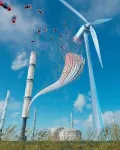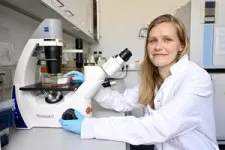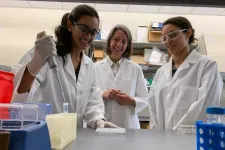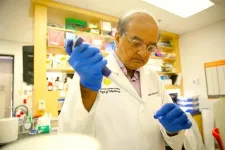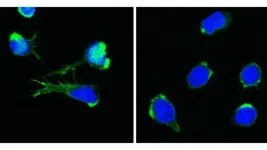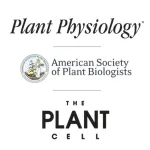(Press-News.org) What started as a simple errand to deposit a check at a bank drive-through became the kind of “aha” moment found mostly in books and movies.
Georgia Tech researchers had been working on an idea to simplify traditional direct air capture (DAC) systems. Their approach used ambient wind flow to draw air across a new kind of coated carbon fiber to grab CO2. That would eliminate the loud fans used in many systems. And the carbon fiber strands could be quickly heated to release the captured carbon dioxide with minimal heat loss, boosting efficiency.
But they were struggling with how to deploy these new sorbent-coated carbon fibers for maximum effect.
“I had to go deposit a check at the bank, and I went through the drive-through. They had the old pneumatic tubes that come down to transport documents,” said Ryan Lively, Thomas C. DeLoach Professor in Georgia Tech’s School of Chemical and Biomolecular Engineering (ChBE). “There are not many times you have a light bulb moment in your career, but I saw the tubes and I realized, we could put the fibers in something like a bank teller tube canister.
“That’s pretty much what we did, and it worked.”
With the pneumatic tube-inspired modules in place, the team began testing their system. They found they could produce carbon dioxide with sufficient purity for underground sequestration and eliminate many of the substantial upfront costs of building typical DAC systems. They described their design and approach in the June 21 issue of the journal Joule.
“This work not only conceptualized a new generation of DAC systems but also showed practical operations of our invention to some extent,” said Won Hee Lee, the paper’s first author and a former postdoctoral scholar in Lively’s lab. “We already successfully captured ambient CO2 with our lab-scale module. Now it’s important to scale up the module. Since all the components of our system are commercially available and fabrication is relatively easy, there should be few technical hurdles to making the module in large scale.”
At least in theory, the team has done that scale-up, using their experimental data to project the economics of a practical system. They and found the system could capture CO2 for $150 to $200 per ton — significantly less than commercial systems under construction that are estimated to capture carbon for $300 to $600 per ton.
A Simpler Approach
The study’s co-authors include researchers in ChBE who’ve positioned Georgia Tech as a leader in direct air capture technology. Professors Christopher Jones and Matthew Realff work with Lively on the full spectrum of DAC, from the molecular to the systems level.
This work presents two key advances.
DAC systems use heat to release CO2 from saturated filter materials. The CO2 is collected and then can be pumped underground or perhaps used to make fuel or chemicals. Typically, systems use an external heating source. Steam is a popular choice, because it’s quick and powerful, but it’s also damaging and requires an extra condensing step. These systems also require insulation to prevent all that heat from escaping, so they’re bulky and expensive.
Lively and the team created unique carbon fiber strands coated with a carbon-loving sorbent. The carbon fiber core heats from the inside out, resulting in fast and even heat distribution.
“The fibers are very, very uniform. When you hook all this up to an electrical system, you distribute that energy remarkably homogeneously, which is unusual for a resistance heating system,” Lively said. “We're not the first to think of resistance heating to regenerate a carbon capture device. But typically, the heating was either slow or not uniform. There are places where you're heating up the air instead of the thing you're trying to heat.”
The researchers’ system uses fewer components overall. The design deploys a series of their bank-tube-inspired modules with carbon fiber strands in a circle to capture CO2 no matter which way the wind blows. The system uses a single vacuum pump that spins from module to module during the regeneration phase. And there’s no need for steam generators, pumps, and condensers to release the CO2 and “recharge” the strands. Both of those changes mean the system is simpler overall and cheaper up front to build and deploy.
“The capital cost of this system is significantly lower than many of the current DAC systems based on the lack of auxiliary systems like steam generation,” Realff said. “The energy cost is still a challenge, and we need to increase the amount of CO2 we can adsorb in the device so that the sensible heating of the fibers does not consume too large a portion of the overall heat.”
But Realff said the rapid heating and fast cycling of the system holds great promise for a more productive approach to direct air capture: “The fact that we could produce a working prototype and demonstrate it at bench scale in months is a remarkable feature of the technology.”
Ideally, the team’s DAC system could be situated with a wind farm, using renewable energy from wind turbines. But even using power from the current grid, Reallf’s analysis showed the team’s design would still remove enough CO2 from the atmosphere to be carbon negative.
Another advantage to the team’s approach is the carbon fiber strand. The material has the right mechanical and electrical properties, and it’s readily available, sustainably manufactured in large quantities, and not prohibitively expensive.
Now the team is looking to boost the quality of the cardon dioxide they can produce. They’ve achieved 80% purity — good enough for underground storage, but they’d like to reach the 99% purity needed for productive reuses like making chemicals or fuels. They’re working with the Georgia Tech Research Institute to refine and automate their system with that goal in mind, and they’re working toward installing a test system atop a campus building.
“I have worked on DAC for over a decade, and almost all designs I have seen rely primarily on heat energy for desorption,” said Jones, who also is ChBE’s John F. Brock III School Chair. “A technology that allows for both rapid, local heating and use of renewable electricity expands the DAC technology developer’s array of design options.”
This research was supported by the Advanced Research Projects Agency–Energy in the U.S. Department of Energy, grant No. DE-AR0001414. Any opinions, findings, and conclusions or recommendations expressed in this material are those of the authors and do not necessarily reflect the views of any funding agency.
Citation: Lee et al., Sorbent-coated carbon fibers for direct air capture using electrically driven temperature swing adsorption, Joule (2023), https://doi.org/10.1016/j.joule.2023.05.016.
END
Inside-out heating and ambient wind could make direct air capture cheaper and more efficient
Chemical engineers use coated carbon fibers and eliminate steam-based heating in their simpler design, which also can be powered by wind energy
2023-06-21
ELSE PRESS RELEASES FROM THIS DATE:
A clean energy transition is possible for China’s manufacturing industry
2023-06-21
The industrial sector – made up of businesses that support processing raw materials for manufacturing and consumer goods – is a major contributor to greenhouse gas emissions and one that has proven difficult to decarbonize. In China, much of the industrial sector is organized into ‘parks’ that have been zoned as areas for concentrated industrial activities. China has more than 2,500 industrial parks that are currently largely powered by coal. A recent study led by researchers at Princeton University finds that this clustering of industry provides unique and overlooked opportunities for targeted energy supply emissions reduction ...
Antarctic ice shelves experienced only minor changes in surface melt since 1980
2023-06-21
Antarctic ice shelves have experienced only minor changes in surface melt rates over the past four decades, unlike the rapid increase in surface melt experienced by Greenland’s glaciers during the same time period, according to new research. The news is not cause for celebration just yet, though—the researchers expect Antarctic ice shelf surface melt rates to increase substantially in the coming decades due to rising global air temperatures.
Ice shelves are the parts of glaciers that extend into the ocean and float on top of seawater. In a new study published today in Geophysical Research Letters, glaciologists ...
Hastings Center partners on AI project led by national academies
2023-06-21
The National Academy of Medicine (NAM) is partnering with a group of leading health, bioethics, equity, tech, patient advocacy, and research organizations, including The Hastings Center, to develop an Artificial Intelligence Code of Conduct (AICC).
Dr. Vardit Ravitsky, incoming president of The Hastings Center, who will serve on the steering committee, said, “we must urgently develop guidance for the ethical use of AI – perhaps the most transformative technology of our generation.” ...
CSU biologists document genome-level climate adaptation in endangered bird species
2023-06-21
As the climate changes, living things must adapt to new environmental conditions in one of two ways – either geographically or genetically. While it’s relatively simple for scientists to track and record a species’ geographic movements, proving their genetic adaptation over time can be much more difficult.
A new study led by Colorado State University researchers in Nature Climate Change is one of the first to document climate adaptation at the genomic level in a wild population. Specifically, the Southwestern Willow Flycatcher – an endangered migratory bird – has shown an increase in genetic variation ...
DNA test could broaden access to cervical cancer screening
2023-06-21
HOUSTON – (June 21, 2023) – Rice University bioengineers have demonstrated a low-cost, point-of-care DNA test for HPV infections that could make cervical cancer screening more accessible in low- and middle-income countries where the disease kills more than 300,000 women each year.
HPV, a family of viruses, infects nearly everyone at some point in their lives, often without symptoms. But more than a dozen types of HPV can cause persistent infections that result in cervical cancer, which is preventable and curable ...
Cancer drugs show potential in fight against malaria
2023-06-21
With malaria becoming increasingly drug-resistant, a team of UCF researchers is looking to use cancer drugs to accelerate the discovery of new life-saving therapies for the disease.
In a study funded by a 5-year $3.8 million grant from the National Institutes of Health, UCF molecular parasitologist Debopam Chakrabarti and cancer molecular biologist Ratna Chakrabarti are partnering with Nathanael Gray, co-leader of the cancer therapeutics research program at Stanford University and Elizabeth Winzeler, a malaria drug development expert from the University of California San Diego, to test cancer drugs for malaria-fighting ...
Newly discovered genetic defect disrupts blood formation and immune system
2023-06-21
(Vienna, 21.06.2023) In the quest to find the origin of the puzzling symptoms in four children, researchers from St. Anna Children's Cancer Research Institute, the CeMM Research Center for Molecular Medicine of the Austrian Academy of Sciences (ÖAW), and the Medical University of Vienna have discovered a completely new disease, linking disruptions of blood formation, the immune system, and inflammation. This groundbreaking discovery provides the basis for a better understanding of similar diseases. It is a milestone that the researchers have now published ...
New study reveals number and strength of head impacts, not concussions, drive CTE risk in football
2023-06-21
Does a football player’s number of concussions drive the risk of developing chronic traumatic encephalopathy (CTE)? In a new study of 631 deceased football players, the largest CTE study to date, scientists found that the number of diagnosed concussions alone was not associated with CTE risk. Instead, football players’ odds of developing CTE were related to both how many head impacts they received and how hard the head impacts were.
The study, conducted by researchers at Mass General Brigham, Harvard Medical School, and Boston University (BU), was published today in Nature Communications. It ...
ASPB Journals launch Author Travel Awards
2023-06-21
ROCKVILLE, MD - Authors whose work has been published in Plant Physiology or The Plant Cell, leading international society journals published by the American Society of Plant Biologists (ASPB), have a new option to support their travel to share their research with the scientific community. Funded by Plant Physiology and The Plant Cell, US$1,000 travel awards will be awarded to authors who have received invitations to give an oral presentation at any conference or scientific meeting around the world. Five US$1,000 awards are available in 2023 with more awards anticipated for 2024 ...
Scientists discover mechanism affecting heart development in Down syndrome
2023-06-21
Infants born with Down syndrome, the genetic condition caused by an extra copy of chromosome 21, or trisomy 21, are highly predisposed to congenital heart defects. It is estimated that nearly half of newborns with Down syndrome have a congenital heart malformation, and Down syndrome is recognized as the most common cause of congenital heart abnormalities. Despite many research efforts over several decades, the mechanisms by which trisomy 21 prevents proper formation of the heart during embryonic development have remained unknown.
A recent study by scientists ...
LAST 30 PRESS RELEASES:
New study highlights link between eviction rates and gun violence
Heatwaves heat up soil but not toxin levels in rice, study finds
Digital modeling reveals where construction carbon emissions really come from
Turning farm waste into water filters
New study shows how the spleen helps the immune system accept a transplant
New Mayo Clinic study advances personalized prostate cancer education with an EHR-integrated AI agent
Researchers identify novel therapeutic target to improve recovery after nerve injury
Microbes in breast milk help populate infant gut microbiomes
Reprogramming immunity to rewrite the story of Type 1 diabetes
New tool narrows the search for ideal material structures
Artificial saliva containing sugarcane protein helps protect the teeth of patients with head and neck cancer
Understanding the role of linear ubiquitination in T-tubule biogenesis
Researchers identify urban atmosphere as primary reservoir of microplastics
World’s oldest arrow poison – 60,000-year-old traces reveal early advanced hunting techniques
Bristol scientists discover early sponges were soft
New study uncovers how rice viruses manipulate plant defenses to protect insect vectors
NSF–DOE Vera C. Rubin Observatory spots record-breaking asteroid in pre-survey observations
Ribosomal engineering creates “super-probiotic” bacteria
This self-powered eye tracker harnesses energy from blinking and is as comfortable as everyday glasses
Adverse prenatal exposures linked to higher rates of mental health issues, brain changes in adolescents
Restoring mitochondria shows promise for treating chronic nerve pain
Nature study identifies a molecular switch that controls transitions between single-celled and multicellular forms
USU chemists' CRISPR discovery could lead to single diagnostic test for COVID, flu, RSV
Early hominins from Morocco reveal an African lineage near the root of Homo sapiens
Small chimps, big risks: What chimps show us about our own behavior
We finally know how the most common types of planets are created
Thirty-year risk of cardiovascular disease among healthy women according to clinical thresholds of lipoprotein(a)
Yoga for opioid withdrawal and autonomic regulation
Gene therapy ‘switch’ may offer non-addictive pain relief
Study shows your genes determine how fast your DNA mutates with age
[Press-News.org] Inside-out heating and ambient wind could make direct air capture cheaper and more efficientChemical engineers use coated carbon fibers and eliminate steam-based heating in their simpler design, which also can be powered by wind energy

